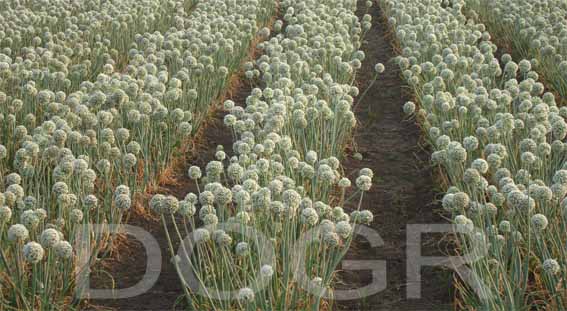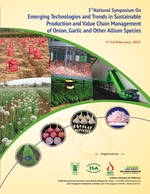SEED PRODUCTION
Onion

Seed is the basic unit of crop production and has greater contribution than environment and cultural factors. India needs around 9400 tons of onion seed annually for covering 11.73 lakh hectares area. Organized sector contribute around 40% of the total seed requirement & rest is met by farmers own seed, often produced without meeting isolation requirement.
1) Method of seed production
a) Seed to seed method
Seedlings after transplanting are allowed to over winter in the field. The bulbs are not lifted and allowed to flower in the same field. This method is not preferred because it doesn’t allow the examination of true to typeness of the onion bulb and rouging of off types and diseased and multicentre bulbs. The genetic purity of the seeds produced from such method is usually poor, though the cost of seed production is less compared to bulb to seed method but this method is not preferred.
b) Bulb to seed method
In the first season the onion bulbs are produce which after maturity are harvested and bulbs which are true to type are sorted and stored. The rabi and late kharif varities are stored for next season and kharif varities are given rest for 15-30 days. The stored bulbs are planted in the next season to produce seeds. Top 1/3 portion of the bulb is cut to examine the number of axis of growing center, preferably single center bulbs should be chosen and soaked in 1g/litre carbondenzim & corbosulphon 1m/litre. This method is widely practised it allows us to examine the bulb characteristics and rouging of undesirable bulbs hence genetic purity is high in this method of seed production
2) Selection of planting material: Bulbs should be true to type in colour and shape, medium to large in size with preferably single centre
3) Maintenance of isolation for genetic purity :
Since onion is highly cross-pollinated crop. An isolation distance of 500 m is kept between two varieties. This is necessary in case of pedigree or certified seed production. For stock or foundation seed production, isolation distance should be kept 1000 m. For mother bulb production 5 m distance from two varieties is recommended to maintain physical purity.
Climate and seasons :
Onion flowering is a thermo-sensitive phenomenon, short day tropical types flower under low temperature 25oC day and 10 – 15oC night, long day temperate types requires low temperature 0–25 oC, Oct.-Nov. planting is the best time for tropical types. As per recommended package of practices, the mother bulbs of Rabi crop should be produced and has to be stored up to October. Bulbs must be stored in well-ventilated storage structure with temperature 25-30oC and RH 65-71%.• Plants developed from bulbs stored at optimum temperature usually flower and mature early and produce higher seed yield.
Planting Spacing Spacing
|
Spacing (cm) |
Av. Bulb Weight(g) |
Quantity of bulbs (q/ ha) |
|
45 x 30 |
50/60/70/80 |
26/31/36/41 |
|
60 x 20 (on drip) |
50/60/70/80 |
30/35/40/ 45 |
Irrigation Methods:
Quantity of water required (ha. Cm) Water saving (%)
Surface 90 --
Drip 67.5 33.3
Sprinkler not recommended as it affects pollination.
Fertilizers:
FYM @ 15 tons/ha, NPK @ 100:50:50 kg/ha apply 50:50:50 kg/ha NPK at the time of planting & remaining nitrogen in 2 splits, one at 30 days and 2nd at 45-60 days after planting. Give 1% spray of Polyfeed (19:19:19, NPK) at 30 & 60 days after planting & one spray of multi K (0:0:50) after 60 days of planting Roguing:
Plot should be visited regularly. Yellow and lanky plants should be removed before flowering; plants with differential umbel height should be removed before
opening of flowers; plants affected by aster yellow and stemphyllium blight should be removed before seed harvest.
Weed Management:
Spray oxyfluoran @ 1.5 ml/L after planting of bulbs and one weeding after 45 to 60 day after planting should be done.
Drying and Threshing :
Dry umbels in open sun, threshing of seed can be done by rolling, threshing machine or combines. The seed should be dried in open sun till 6 to 7 per cent moisture level is attained.
Average Seed yield:
500 – 800 kg seed/ha, in best management and climatic conditions 1000 to 1200 kg seed can be obtained
Seed packing:
Seed should be packed in 400 gauge poly bags after perfect drying.
Storage of seed:
Room temperature : 30 – 35 oC for 15–18 months, Cold Storage : 15 oC with 30–40%RH for 3-4 Years.
Seed Village concept:
Out of 9400 tons of seed requirement only 40 per cent is produced under organised sectors by following norms of isolation by utilising released varieties. Remaining quantity of seed is produced by farmers without following proper norms of seed isolation. Besides, farmers use their own genotypes which suffer from many drawbacks. Every year there is mixture in their stock if they are not produced with optimum isolation distance. Because of this new varieties are not moving fast. There is need for production seed of one variety in one village. This is called seed village concept. The required good quantity seed can be produced in the village. By doing so a village can develop their own brand by marketing.















